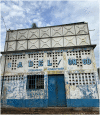Study design and baseline to evaluate water service provision among peri-urban communities in Kasai Oriental, Democratic Republic of the Congo
- PMID: 37053145
- PMCID: PMC10101432
- DOI: 10.1371/journal.pone.0283019
Study design and baseline to evaluate water service provision among peri-urban communities in Kasai Oriental, Democratic Republic of the Congo
Abstract
We present a study design and baseline results to establish the impact of interventions on peri-urban water access, security and quality in Kasai Oriental province of the Democratic Republic of the Congo. In standard development practice, program performance is tracked via monitoring and evaluation frameworks of varying sophistication and rigor. Monitoring and evaluation, while usually occurring nearly concurrently with program delivery, may or may not measure parameters that can identify performance with respect to the project's overall goals. Impact evaluations, often using tightly controlled trial designs and conducted over years, challenge iterative program evolution. This study will pilot an implementation science impact evaluation approach in the areas immediately surrounding 14 water service providers, at each surveying 100 randomly-selected households and conducting water quality assessments at 25 randomly-selected households and five water points every three months. We present preliminary point-of-collection and point-of-use baseline data. This study is utilizing a variety of short- and medium-term monitoring and impact evaluation methods to provide feedback at multiple points during the intervention. Rapid feedback monitoring will assess the continuity of water services, point-of-consumption and point-of-collection microbial water quality, household water security, household measures of health status, ability and willingness to pay for water and sanitation service provision, and service performance monitoring. Long-term evaluation will focus on the use of qualitative comparative analysis whereby we will investigate the combination of factors that lead to improved water access, security and quality.
Copyright: © 2023 Kirsch et al. This is an open access article distributed under the terms of the Creative Commons Attribution License, which permits unrestricted use, distribution, and reproduction in any medium, provided the original author and source are credited.
Conflict of interest statement
This study is funded by the U.S. Agency for International Development under the terms of contract Number: 72066020C00001 and implemented by Chemonics. The funders have no role in study design, randomization, data collection and analysis, or decision to publish.
Figures




Similar articles
-
Formative research for the development of baby water, sanitation, and hygiene interventions for young children in the Democratic Republic of the Congo (REDUCE program).BMC Public Health. 2021 Mar 1;21(1):427. doi: 10.1186/s12889-021-10246-5. BMC Public Health. 2021. PMID: 33648466 Free PMC article.
-
High levels of faecal contamination in drinking groundwater and recreational water due to poor sanitation, in the sub-rural neighbourhoods of Kinshasa, Democratic Republic of the Congo.Int J Hyg Environ Health. 2018 Apr;221(3):400-408. doi: 10.1016/j.ijheh.2018.01.003. Epub 2018 Jan 10. Int J Hyg Environ Health. 2018. PMID: 29396027
-
Formative Research for the Development of Evidence-Based Targeted Water, Sanitation, and Hygiene Interventions to Reduce Cholera in Hotspots in the Democratic Republic of the Congo: Preventative Intervention for Cholera for 7 Days (PICHA7) Program.Int J Environ Res Public Health. 2022 Sep 27;19(19):12243. doi: 10.3390/ijerph191912243. Int J Environ Res Public Health. 2022. PMID: 36231546 Free PMC article.
-
Urban Water Access and Use in the Kivus: Evaluating Behavioural Outcomes Following an Integrated WASH Intervention in Goma and Bukavu, Democratic Republic of Congo.Int J Environ Res Public Health. 2022 Jan 18;19(3):1065. doi: 10.3390/ijerph19031065. Int J Environ Res Public Health. 2022. PMID: 35162089 Free PMC article.
-
Community health outreach program of the Chad-Cameroon petroleum development and pipeline project.Clin Occup Environ Med. 2004 Feb;4(1):9-26. doi: 10.1016/j.coem.2003.09.004. Clin Occup Environ Med. 2004. PMID: 15043361 Review.
Cited by
-
Understanding facilitators and barriers to vitamin A supplementation uptake among children under five in the Kasaï-Oriental province, Democratic Republic of the Congo: a qualitative study.BMC Nutr. 2025 Aug 2;11(1):156. doi: 10.1186/s40795-025-01142-x. BMC Nutr. 2025. PMID: 40753241 Free PMC article.
References
-
- Pickering AJ, Crider Y, Sultana S, Swarthout J, Goddard FG, Anjerul Islam S, et al.. Effect of in-line drinking water chlorination at the point of collection on child diarrhoea in urban Bangladesh: a double-blind, cluster-randomised controlled trial. The Lancet Global Health. 2019;7(9):e1247–e1256. doi: 10.1016/S2214-109X(19)30315-8 - DOI - PubMed
-
- Ngasala TM, Gasteyer SP, Masten SJ, Phanikumar MS. Linking Cross Contamination of Domestic Water with Storage Practices at the Point of Use in Urban Areas of Dar es Salaam, Tanzania. Journal of Environmental Engineering. 2019;145(5). doi: 10.1061/(ASCE)EE.1943-7870.0001516 - DOI
-
- Quattrochi JP, Coville A, Mvukiyehe E, Dohou CJ, Esu F, Cohen B, et al.. Effects of a community-driven water, sanitation and hygiene intervention on water and sanitation infrastructure, access, behaviour, and governance: a cluster-randomised controlled trial in rural Democratic Republic of Congo. BMJ Global Health. 2021;6:e005030. doi: 10.1136/bmjgh-2021-005030 - DOI - PMC - PubMed
-
- Danert K, Hutton G. Shining the spotlight on household investments for water, sanitation and hygiene (WASH): let us talk about HI and the three ‘T’s. Journal of Water, Sanitation and Hygiene for Development. 2020;10(1):1–4. doi: 10.2166/washdev.2020.139 - DOI
-
- UN Water. National Systems to Support Drinking-Water, Sanitation and Hygiene: Global Status Report 2019; 2019. Available from: http://apps.who.int/bookorders
Publication types
MeSH terms
LinkOut - more resources
Full Text Sources

